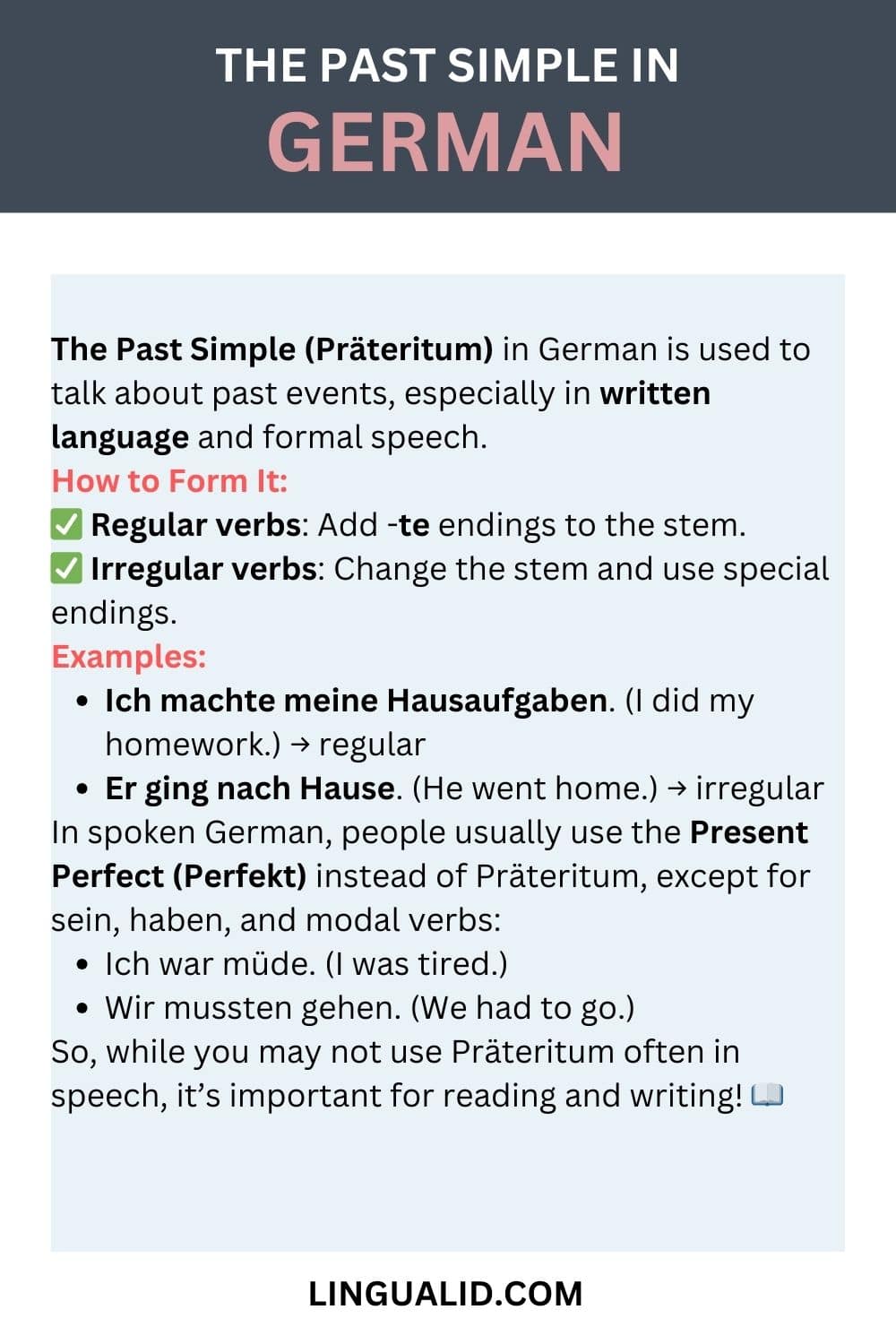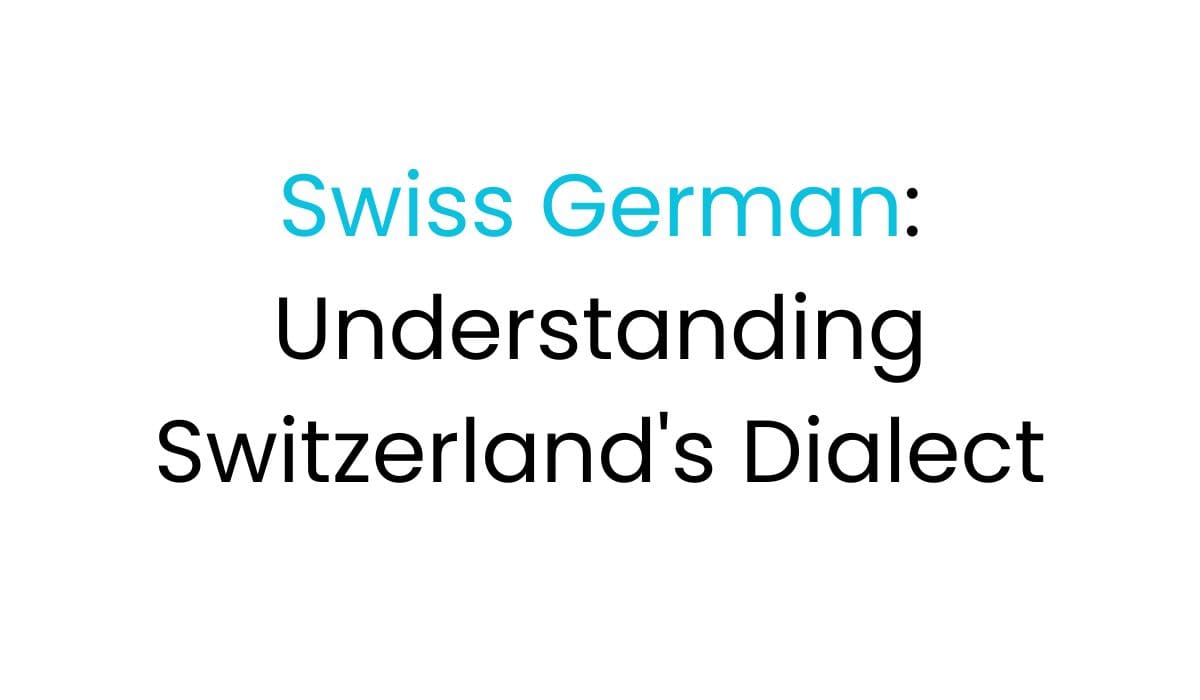Learning the Past Simple in German can really boost your skills. About half of German verbs are irregular in the Präteritum (Simple Past Tense). Knowing this is key for clear communication.
Getting good at the Präteritum takes practice and a smart plan. Native speakers often use it in formal writing. It’s a must for advanced learners wanting to improve their German.
This guide will help you understand the German Präteritum. We’ll cover verb conjugation and how to use it in different situations.

- Understanding German Past Tense Basics
- Past Simple in German: Formation and Structure
- Regular Verb Conjugation in Past Simple
- Irregular Verb Conjugation Rules
- Common Strong Verbs and Their Past Forms
- Modal Verbs in Past Simple
- Written vs Spoken Usage of Past Simple
- Common Mistakes to Avoid
- Past Simple vs Present Perfect in Everyday German
- FAQ
- What is the difference between Präteritum and Perfekt in German?
- How do I form the past simple (Präteritum) for regular verbs?
- Are there any tricks to remembering irregular verb conjugations?
- When should I use Präteritum instead of Perfekt?
- What are strong verbs in German?
- How do modal verbs work in the past simple?
- What are the most common mistakes learners make with German past tense?
- How can I practice German past simple tense effectively?
- Do all German verbs follow the same past tense conjugation rules?
- Is the German past simple tense difficult to learn?
Understanding German Past Tense Basics
Learning the German past tense can be tough. The German grammar has two main ways to talk about past events. Each has its own rules and when to use them. Knowing these will help you speak and write German better.
The imperfect tense, called Präteritum, is key for telling stories. It’s mostly used in written German. About 70% of stories in books and newspapers use this tense.
What Makes German Past Tense Unique
German past tense is different from English. It has two main forms:
- Präteritum (Simple Past Tense)
- Perfekt (Present Perfect Tense)
Different Types of Past Tense in German
Each type has its own use in German grammar:
- Präteritum: Used in formal writing and stories
- Perfekt: More common in spoken German, used about 80% of the time
Contextual Usage of Past Tenses
Where you are affects which tense you use. In southern Germany, like Bavaria and Austria, people often use the present perfect tense in everyday talks.
Choosing between Präteritum and Perfekt depends on the situation, how formal it is, and where you are. Getting these right will make your German much better.
Past Simple in German: Formation and Structure
Learning German verb conjugation in the past simple tense is easier with practice. Regular verbs in German are a great place to start. They follow a simple pattern for the past tense.
To form the past tense of regular verbs, remove the “-en” ending. Then, add specific endings based on the subject. This method helps learners predict how most verbs are conjugated.
- Remove the “-en” ending from the verb
- Add appropriate person-specific endings
- Use the modified verb stem for conjugation
Now, let’s look at how regular verbs are typically conjugated:
| Person | Ending | Example with “lernen” |
|---|---|---|
| ich (I) | -te | lernte |
| du (you, informal) | -test | lerntest |
| er/sie/es (he/she/it) | -te | lernte |
| wir (we) | -ten | lernten |
| ihr (you, plural) | -tet | lerntet |
| sie/Sie (they/formal you) | -ten | lernten |
Some verbs need extra attention. Verbs ending in -d or -t get an extra “e” before the ending. This helps with pronunciation and keeps grammar correct in German verb conjugation.
Regular Verb Conjugation in Past Simple
German verb conjugation in the past simple tense is easy and logical for regular verbs. Knowing these patterns helps you speak Deutsch confidently. It makes talking about past actions simple.
Regular verbs in German, known as weak verbs, follow simple rules. These verbs add specific endings to their stems in the past simple tense.
Common Regular Verb Patterns
The main rule for regular verbs in the past simple tense is:
- -te for ich (I) and er/sie/es (he/she/it)
- -test for du (you, informal singular)
- -tet for ihr (you, informal plural)
- -ten for wir (we), Sie (formal you), and sie (they)
Special Endings for Regular Verbs
Be careful with verbs ending in “-d” or “-t”. Add an extra “-e” before the ending for better pronunciation.
| Verb | Infinitive | Past Simple (ich/er/sie/es) |
|---|---|---|
| arbeiten (to work) | arbeiten | arbeitete |
| antworten (to answer) | antworten | antwortete |
| hören (to hear) | hören | hörte |
Practice Examples with Regular Verbs
Here are some examples of German verb conjugation in the past simple tense:
- spielen (to play):
- ich spielte (I played)
- du spieltest (you played)
- wir spielten (we played)
- sagen (to say):
- ich sagte (I said)
- du sagtest (you said)
- sie sagten (they said)
By practicing these examples, you’ll get better at regular verb conjugation in German. This will help you build a strong foundation in the language.
Irregular Verb Conjugation Rules
German grammar is full of interesting irregular verb past tense forms. About 200 irregular verbs make up half of all German verb forms. These verbs don’t follow the usual patterns, making learning them a unique challenge.
Irregular verbs in German grammar are divided into three main types:
- Strong verbs: Change their stem vowel in past tense
- Mixed verbs: Combine regular endings with stem changes
- Completely irregular verbs: Unique conjugation patterns
Important verbs like sein (to be), haben (to have), and werden (to become) show the biggest differences from regular rules.
| Verb Type | Example | Present Tense | Past Tense |
|---|---|---|---|
| Strong Verb | fahren (to drive) | ich fahre | ich fuhr |
| Mixed Verb | wissen (to know) | ich weiß | ich wusste |
| Modal Verb | können (can) | ich kann | ich konnte |
Mastering these irregular verb past tense forms takes a lot of practice. Using mnemonic devices, flashcards, and language apps can help. With regular practice, you can get better at handling German irregular verbs and boost your language skills.
Common Strong Verbs and Their Past Forms
Learning German irregular verb past tense can be tough. Strong verbs are a special group in Präteritum. They change their vowels when conjugated.
Strong verbs stand out because of their unique vowel changes. Unlike regular verbs, they change their vowel sounds. This creates different past tense forms that learners must remember.
Most Frequently Used Strong Verbs
Language learners should focus on these common strong verbs:
- gehen (to go): ging, gegangen
- sehen (to see): sah, gesehen
- essen (to eat): aß, gegessen
- fahren (to drive): fuhr, gefahren
- schlafen (to sleep): schlief, geschlafen
Memorization Tips and Tricks
Learning strong verbs needs smart strategies. Try these methods:
- Create flashcards with verb forms
- Practice frequent verb patterns
- Use mnemonic devices
- Listen to native speakers
Examples in Context
Understanding Präteritum means seeing verbs in real sentences. For example: “Ich ging gestern ins Kino” (I went to the cinema yesterday) shows how irregular verbs work in sentences.
Mastering strong verbs takes time and practice. Focus on patterns and use them often to get better at German.
Modal Verbs in Past Simple
Modal verbs are key in German grammar, especially in the simple past tense. They have special ways of changing that are different from other verbs. Knowing how to use them is important for clear communication.
In German, there are six main modal verbs to learn:
- dürfen (to be allowed to)
- können (to be able to)
- wollen (to want)
- müssen (to must)
- sollen (should)
- mögen (to like)
These modal verbs usually use the simple past tense, even in everyday German. This is different from other past tense rules, which often use the present perfect.
Here are the past simple forms for some common modal verbs:
- Ich konnte (I could)
- Du durftest (You were allowed)
- Er/Sie wollte (He/She wanted)
- Wir mussten (We had to)
It’s important to know how to change these modal verbs. Using them in the Präteritum helps express ideas more clearly. This skill is essential for mastering German grammar.
Written vs Spoken Usage of Past Simple
It’s key to know the difference between spoken and written Präteritum. The language has many ways to talk about past events. The right tense depends on the situation.
Formal Writing Contexts
For academic papers, professional documents, or books, writers use the Simple Past. This tense is great for clear, structured stories.
Literary and Narrative Usage
Authors often pick the Simple Past for stories. Novels, historical accounts, and journalistic writing use it for a smooth story.
Business Communication
Business talks need to be precise. Reports and formal letters use the written past in German. This keeps the message clear and professional.
For German learners, a good tip: if you’re not sure, use the Present Perfect (Perfekt) tense in talks.
Common Mistakes to Avoid

Learning the Präteritum can be tricky. It’s important to watch out for common mistakes. These errors can make your German grammar and speaking skills better.
Many learners face challenges with the Präteritum. The main mistakes include:
- Mixing regular and irregular verb conjugations
- Incorrectly placing separable prefixes
- Overusing past simple in spoken German
- Failing to follow correct verb placement rules
Many learners find German pronunciation and grammar hard. Consistent practice is crucial to avoid these mistakes.
One big challenge is knowing when to use past simple versus present perfect. Native speakers often use Perfekt (present perfect) in everyday German. This can confuse learners trying to get the hang of past simple.
- Avoid directly translating English past tense structures
- Practice verb conjugations regularly
- Listen to native speakers to understand natural usage
- Use interactive learning resources
Studies show that engaging with cultural content can boost motivation and retention by up to 35%. By knowing these common mistakes, you’ll improve your German speaking skills.
Past Simple vs Present Perfect in Everyday German
In spoken German, the present perfect tense is used a lot to talk about past events. People rarely use the Imperfekt tense in everyday talk. This makes learning the spoken past in German tricky.
It’s important to know the difference between past simple and present perfect to sound natural. While Imperfect is common in written German, conversations need a different approach. Germans usually use the present perfect tense to talk about past actions.
Understanding when to use each tense is key. In formal writing, you’ll see the simple past a lot. But when talking with friends, the present perfect is better. This helps you sound more like a native speaker.
Immersion is the best way to learn. Listen to native speakers, watch German movies, and practice using these tenses. With time, you’ll know when to use Imperfect or present perfect.
FAQ
What is the difference between Präteritum and Perfekt in German?
How do I form the past simple (Präteritum) for regular verbs?
Are there any tricks to remembering irregular verb conjugations?
When should I use Präteritum instead of Perfekt?
What are strong verbs in German?
How do modal verbs work in the past simple?
What are the most common mistakes learners make with German past tense?
How can I practice German past simple tense effectively?
Do all German verbs follow the same past tense conjugation rules?
Is the German past simple tense difficult to learn?
Oualid Cheddadi is the founder of Lingualid, a platform that inspires independent language learners worldwide, regardless of the language they are learning. The name “Lingualid” is derived from the Portuguese word for “language,” “língua,” and the last three letters of Oualid’s name, “Lid.”



